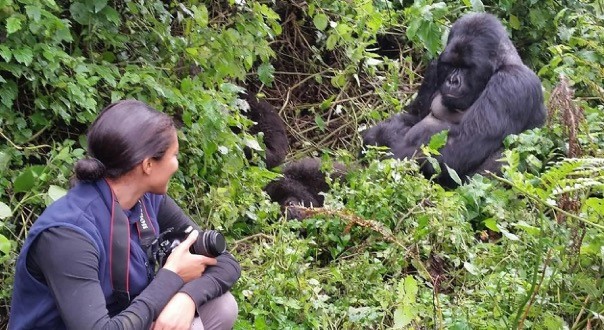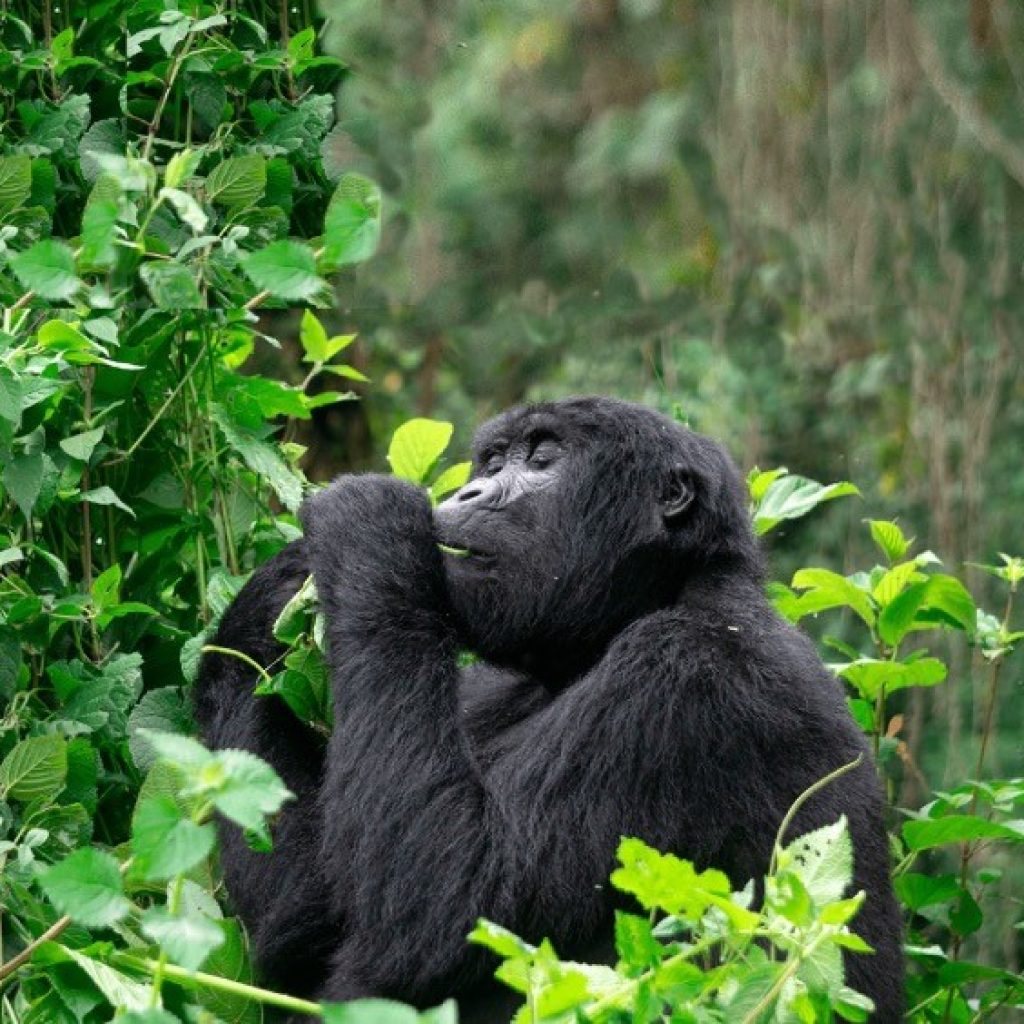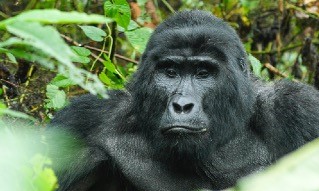
Discover the magic in Uganda, where 21 habituated gorilla families provide an unparalleled wildlife experience. To ensure their serenity, the Uganda Wildlife Authority (UWA) permits only eight adventurers to visit each family for only one hour a day.
By Titus Kakembo
Under the guidance of the silverback, the group’s formidable leader, you will embark on an exhilarating trek through lush forests, tracing their previous night’s nest, footprints and waste to encounter these elusive creatures up close.
Along the way, children from nearby communities greet trekkers with cheerful “hello there.” In the distance, the landscape unfolds
with breathtaking views of mist-covered volcanoes. The challenging trek can take 30 minutes to four hours and involves applying insect repellants, hopping over water streams, navigating thorny plants and scaling the cliffs. This is as one navigates through the bush with mist above a green canopy of leaves. Open fields give way to dense forest and chest-high vegetation. The Uganda Wildlife Authority (UWA) senior warden Richard Muhabwe tips trackers during the briefing about sections where a guide uses a machete to clear a path.
After a trek of varying lengths, the dramatic moment unfolds like a theatre curtain on stage. It implies coming face-to-face with the gorilla family. The encounter is such a memorable action-packed experience.


On their stage in their habitat, the majestic gorillas glance at guests with combined curiosity and indifference before resuming their routines. Mothers are seen basking in the sun and shielding their eyes with their hands. Elsewhere, infants playfully climb treetops, and tease the silverback, the dominant male, with twigs. He is often seen in deep contemplation, chewing on leaves and consuming substantial amounts of food, about 15 per cent of his body weight daily. Nearby are the blackbacks, the teenage males, that go about frolicking with exuberance. As the allotted 60 minutes draw close, the guide will signal when it is time to depart. Guests typically leave with a profound sense of satisfaction, their memory cards filled with photos and videos capturing the moment. The experience often leaves trekkers with a deeper understanding of the remarkable connection between gorillas and humans. It’s not uncommon for these magnificent creatures to brush past tourists or even grab and return a camera, underscoring the intimate bond they share with awed trekkers.
Gorillas Nature Facts
The endangered mountain gorillas, around 1,100 individuals, inhabit only the Virunga ranges spanning Uganda, Rwanda, and the Democratic Republic of the Congo. Impressively, half of these majestic creatures reside in Bwindi Impenetrable Forest and Mgahinga National Park – in Uganda.
Due to rising conservation costs, further strained by the COVID-19 pandemic, the price of a tracking permit has increased from $600 to $700. This adjustment helps the Uganda Wildlife Authority (UWA) manage the growing expenses of protecting these remarkable animals.
During the pandemic, there was encouraging news about a significant baby boom among the 21 habituated gorilla families in Bwindi’s 331 square kilometres of forest. Some groups even ventured to the UWA offices when rangers and trackers failed to reach their habitats, according to UWA Executive Director Sam Mwandha.
In Bwindi, gorilla families can be accessed through Rushaga, Nkuringo, Ruhija and Buhoma. For many trackers, the 60-minute encounter is just the beginning. The gorilla habituation experience, priced at $1,500, extends this time to four hours and involves a rigorous process of acclimating gorillas to human presence over 3-5 years. This immersive experience includes expert guides who help visitors observe gorillas up-close.
“The habituation process starts with park rangers maintaining a safe distance and gradually increasing their presence to minimize stress on the gorillas. Over time, the gorillas become accustomed to the rangers and humans,” Mwandha explains.
Gorilla tracking is a magical experience, enriched by natural sounds, misty scenery and vibrant birdlife. Bwindi Impenetrable and Mgahinga Gorrila National Park are paradise for bird enthusiasts, teeming with diverse species. The Tambourine doves’ cooing, the hornbills’ stuttering chainsaw calls, and the tree branches rustling as monkeys leap through the forest canopy add to the enchantment.

UWA Conservation Strategies
The Uganda Wildlife Authority (UWA) has employed various strategies to promote conservation and improve community livelihoods. In Kanungu district, the 7,205-hectare Kayonza Growers Tea Factory is a vital buffer zone. Here, local communities were trained in conservation practices such as planting indigenous trees, conserving wetlands, and crafting sustainable artefacts.
“They are protecting riverbanks and using tea to deter gorillas from encroaching on their homes and gardens. This approach benefits nature and local economies significantly,” explains Hangi Bashir, UWA senior spokesperson.

In the Bwindi region, the charity organization, ‘Ride For A Woman’ supports women, including survivors of HIV and gender-based violence. At Noel’s Cottage, women serve delicious meals, drinks and local delicacies. They also run a drama group that entertains trekkers and provides coffee and cookies before their expeditions from the UWA headquarters. “Domestic and expatriate tourists celebrate our culture,” says Richard Muhabwe, senior warden.Replanting indigenous plants and encouraging local communities to grow fast-maturing trees for timber and firewood are also key components of UWA’s strategy. Community members are urged to use energy-efficient stoves and to plant trees whenever possible.
Volunteer village teams, rewarded with tokens of appreciation, have constructed a Buffalo Wall to protect park borders.
However, during the dry season, problem animals sometimes breach the wall, causing damage to gardens.
In Kisoro, efforts to mitigate wildlife-human conflict have included the installation of rainwater harvesting tanks. These tanks have reduced the need for children and women to gather water from the park. Led by team leader Jack Rutunda, the initiative has since 2010 transformed lives across three parishes. “There are tanks in Gisozi, Gisenyi, Rukonyi, Mubamba and Nyamusiza, each holding 3,000 litres, benefitting over 300 homes.
The communities have also formed saving schemes and cultivate potatoes, onions and peas,”
Rutunda notes.
The Great Virunga Transboundary Collaboration (GVTC), which implements this project, is expanding its efforts to Musanze in Rwanda to address similar challenges. Headquartered in Rwanda, GVTC facilitates seamless data sharing on gorilla movements across three countries.
“Primates do not recognize borders; their movements are driven by food availability, climate, and territorial conditions,” says GVTC representative Ismail Ochen.Established 25 years ago, GVTC coordinates the efforts of UWA (Uganda Wildlife Authority), ICCN (Institute Congolais pour la Conservation de la Nature), and OPTPN (Office Rwandais du Tourisme et des Parcs Nationaux).
Together, these organizations are committed to conserving the Virunga region, a 1,200-square-kilometre area known for its rich biodiversity, diverse habitats and vibrant communities.
Guests typically leave with a profound sense of satisfaction, their memory cards filled with photos and videos.
The minimum age for gorilla tracking is 15 years. The adventure is on the calendar all year round, with temperatures ranging from 20-25°C. Many tourists prefer the dry seasons (June to August and December to February) to avoid slippery trails. The March to May and October to November wet season offers exceptional conditions for photography, the ideal conditions for capturing these incredible creatures on camera in their dense habitat.